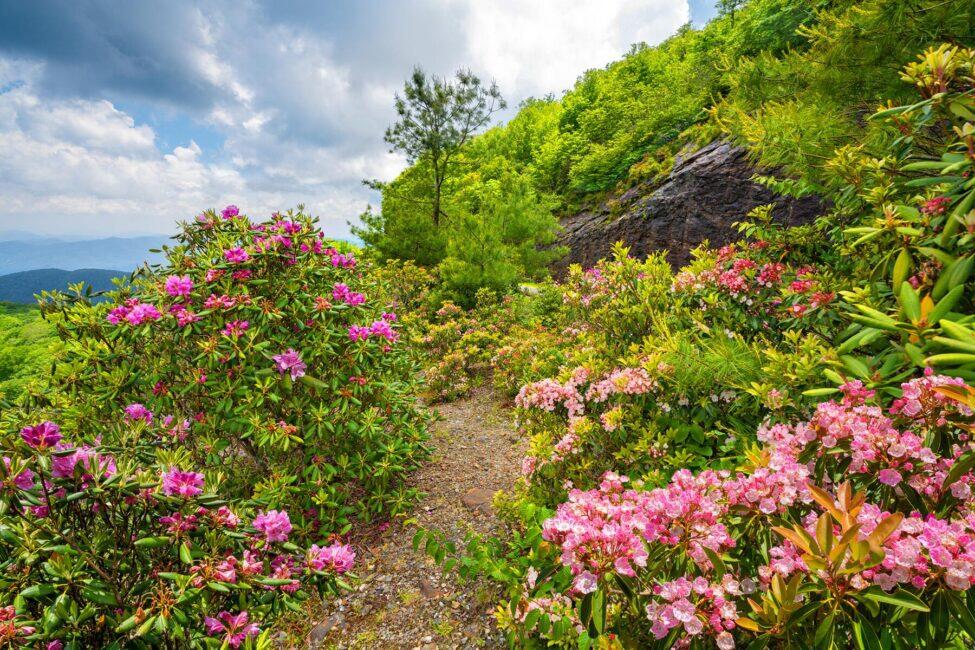Chase the most beautiful seasonal bloom in America.
Come spring, wildflowers start blooming like crazy, and gardens begin to open for the season in much of the northern tier of the United States.
This year, if you are taking a road trip from the south to the north, you can follow the Spacious Skies Campgrounds Spring Bloom Trail to experience wildflowers at their peaks of perfection. The 15-stop trail connects campgrounds between Georgia and Maine and has been tagged to coincide with the wildflowers blooming near each site as well as local festivals and events.
“Savoring the journey is a big part of the camping experience, and the Spring Bloom Trail offers a great way to do just that,” says Ali Rasmussen, co-founder of Spacious Skies Campgrounds. (Spacious Skies has also created a Fall Colors Trail, which goes from the northeast to the southeast for travelers heading south and will be posted on their website later in the year.)
Rasmussen says you don’t need to be a camper to enjoy the blooms, either. Spacious Skies campsites also offer cabins, yurts, and retro trailers for rent. Travelers who join their loyalty program for $31.90 a year can save up to 12 percent on all accommodations.
Recommended Fodor’s Video
Starting the Bloom Trail in Georgia
The Spacious Skies trail starts in Savannah, Georgia, at the Savannah Oaks location west of the city. Wildflowers like azaleas, camellias, and dogwoods start to bloom here in March. According to Rasmussen, the best places to view them are Forsyth Park, Bonaventure Cemetery, and the Historic District of Savannah.
The next stop on the trail is 276 miles north at the Spacious Skies Peach Haven campground in Gaffney, South Carolina. There are more than 680 wildflower species in the state of South Carolina. Blooms begin in March and include oconee bell, trillium, balloon vine, white baneberry, bulbous buttercup, bloodroot, eastern red columbine, butterflyweed, and narrowleaf evening primrose. Prime viewing spots are Devil’s Fork State Park and Table Rock State Park.
The third stop is in Monterey, Tennessee, at Spacious Skies Belle Ridge, about 272 miles from Gaffney. Wildflowers begin blooming here in late March. Varieties like the endangered Virginia spirea, purple phacelia, spring beauty, oxeye daisy, sweet white trillium, and chicory can be spotted in Cummins Falls State Park, Burgess Falls State Park, and along Spacious Skies Belle Ridge hiking trails and the Tennessee Central Heritage Rail Trail.

Continuing on to North Carolina
Traveling on to North Carolina for 223 miles, the trail’s next stop is at Spacious Skies Bear Den in Spruce Pine, which is very close to the Blue Ridge Parkway, one of the most scenic drives in America. Wildflowers like buttercups, eastern redbud, Queen Anne’s lace, and wild geranium start blooming here in late March. Rasmussen says prime spotting sites include the trails at Linville Falls, the Blue Ridge Parkway Craggy Picnic Area, along the shoreline of Julian Price Lake, and at Mount Mitchell State Park.
The fifth stop on the trail is at Spacious Skies Hidden Creek in Marion, North Carolina, just 27 miles up from Spruce Pine in the Blue Ridge Mountains. Wildflowers start to bloom here in late March and can be found at Craggy Gardens Pinnacle Trail along the Blue Ridge Parkway, Max Patch Summit in Pisgah National Forest, Lake James State Park, the Biltmore Estate, and the North Carolina Arboretum. Varieties include rhododendrons, mountain ash, daisies, and dogwood. There are around 1,600 plant species along the Blue Ridge Parkway, and 80% of them are wildflowers, according to the National Park Service.
Moving on to Fayetteville, North Carolina, Spacious Skies Sandy Run is 235 miles from Marion and features wildflowers like Jack-in-the-Pulpit, creeping phlox, ironweed, cardinal flower, flowering dogwood, and Siberian wallflower. Starting in March, you can view them at Cape Fear Botanical Garden and J. Bayard Park & Nature Center.
Next Stop: Virginia
In Virginia, you’ll find the Spacious Skies Shenandoah Views, 331 miles north and also in the Blue Ridge Mountains near Shenandoah National Park. Blooms begin in early April and last through early October, featuring varieties like hepatica, aster, Turk’s cap lily, spiderwort, anemones, and wild azaleas. The famous Skyline Drive and the hiking trails in Shenandoah National Park are great spots to encounter these blooms.
Onward to New Jersey & New York
The next site up on the trail is Spacious Skies Country Oaks in Dorothy, New Jersey, 243 miles away. Wildflowers such as sea rocket, sea lavender, black-eyed Susan, purple loosestrife, and crimson-eyed rose mallow begin blooming in mid-April and can be viewed at the Warren E. Fox Nature Center and along the New Jersey shoreline.
In Austerlitz, New York, in the Taconic and Berkshire Mountains of Upstate New York, Spacious Skies Woodland Hills is 259 miles from Dorothy. Wildflowers common to this area are red trillium, wild blue phlox, northern wood sorrel, Queen Anne’s lace, bee balm, and goldenrod, with blooms starting in early April. You can find them at the Berkshire Botanical Garden and the Vanderbilt Mansion.
Spacious Skies Adirondack Peaks is the tenth site on the trail, 133 miles north of Austerlitz in North Hudson, New York. In early April, wildflowers such as blue flag, cardinal flower, cottongrass, pickerelweed, and northern pipewort begin blooming. You can spot them at the campground’s walking trails and Hammond Pond Wild Forest.

Massachusettes and New Hampshire
Late April brings blooms to the Spacious Skies Minute Man campsite 202 miles from North Hudson in Littleton, Massachusetts. Wildflower species include wild orchid, foxglove, rosebay willowherb, and meadowsweet, and can be spotted along the Nashua River Rail Trail and on the hiking and biking trails at Oak Hill Park.
Moving further north 44 miles to New Hampshire, the Spacious Skies Seven Maples in Hancock (home of Dartmouth College) starts blooming in mid-May with wildflowers like golden Alexanders, wild columbine, sundial lupine, and Ohio spiderwort. The best places to spot these wildflowers are at Monadnock State Park and dePierrefeu-Willard Pond Wildlife Sanctuary.
Also in New Hampshire, in Henniker, Spacious Skies French Pond is just 22 miles from Hanover. Blooms begin here in early May, with varieties of wildflowers like lupine, bluets, pink lady’s slipper, fringed polygal, and blue violets. You can see them in Clough State Park, Mount Sunapee State Park, and in wooded areas and creek beds.
Ending the Trail in Maine
Towards the end of the trail, 75 miles away in Alfred, Maine, the Spacious Skies Walnut Grove is located in central southern Maine. The blooms here start in late April and include purple and yellow violets, sweet white violets, and white trillium. Look for them at the Wells Reserve and the Marginal Way Coastal Walkway.
The final stop on the trail is Spacious Skies Balsam Woods in Abbot, Maine, 162 miles from Alfred. Wildflowers start blooming here in mid-May; you’ll find painted trillium, blue violets, trout lily, and trailing arbutus at Low’s Bridge, on the banks of the Piscataquis River, and at Moosehead Lake and Piper Pond.
Bloom Trails Are Everywhere
If you don’t happen to be traveling near a Spacious Skies campsite, you can check out trails created by other organizations. Most states, in fact, lean heavily into spring flowers and feature them in parks and botanical gardens. I LOVE NY; New York State’s Tourism Program, for instance, posts a weekly report for gardens, parks, and other partners ranging from New York City to the Hudson Valley, the Catskills, the Finger Lakes, and western New York State to guide visitors interested in following the flowers. Bloom updates are posted on their website every Wednesday afternoon.

Chasing Tulips in the Pacific Northwest, Midwest, and California
Tulips are a notable feature of spring in several spots around the US. The flowers originated in Asia as wildflowers. In Washington State, Skagit Valley produces most of the tulip and daffodil bulbs sold in the US. Four tulip fields are featured in its annual Tulip Festival driving tour, which is held in April: Roozengaarde, Tulip Town, Garden Rosalyn, and Tulip Valley Farm. You can walk along tulip trails, view curated gardens, and even pick your own tulips at some of the venues. The festival organizers create a bloom map on their website that is filled in as the season progresses to show where you can find the most blooms.
In the Midwest, Tulip Time in Holland, Michigan, has been holding an eight-day festival each spring (this year’s festivities run from May 4-12) for the past 95 years to honor tulips and the city’s Dutch heritage. The Tulip Immersion Garden contains over 65,000 tulips.
In Maple Park, Illinois, the Midwest Tulip Fest at the Kuipers Family Farm features close to half a million tulips spread over a 7-acre farm. This year, from April 27 to May 19, you can walk the fields, take photographs among the blooms, and even cut some tulips to purchase and take home.
Another spring flower from Asia, the ranunculus, like the tulip, is a harbinger of spring. One of the best places to view it in volume is in Carlsbad, California, where Giant Tecolote Ranunculus flowers bloom from early March through early May over 55 acres at The Flower Fields at Carlsbad Ranch.



